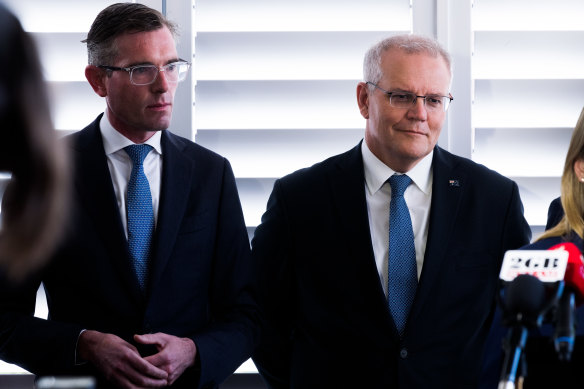Save articles for later
Add articles to your saved list and come back to them any time.
The NSW Liberals’ election post-mortem has blamed former prime minister Scott Morrison, the “dysfunction” of the party’s state executive, and an “It’s time” factor for its loss at the March poll.
Seven months after the Liberals lost their last mainland stronghold when former premier Dominic Perrottet’s government was defeated by Labor’s Chris Minns, a review of the campaign has highlighted the Morrison government for damaging the party’s brand before the poll.
A review of the NSW Liberal Party’s election loss has blamed the Morrison government for damaging the party’s brand in the lead-up to the poll.Credit: James Brickwood
Led by former NSW premier Nick Greiner and former NSW MP Peta Seaton, the review also placed significant blame on the “dysfunction” of the party’s state executive, which was crippled by factional infighting.
Greiner and Seaton briefed MPs on their findings on Tuesday, telling the Liberal party room that the No.1 reason for the party’s loss was the “It’s time” factor after 12 years in power.
But damage to the party’s brand was a significant factor, they said, specifically citing the unpopularity of the Morrison government as a key influence in the loss.
According to MPs present at Tuesday’s briefing who spoke on the condition of anonymity because of the confidentiality of the report, Greiner opened the meeting by saying the party’s brand was damaged by the 2022 federal election on key issues such as women and the environment.
Greiner also said, “significant damage” had been caused by events after the election, according to those MPs. While he didn’t cite specific examples, MPs who spoke to this masthead pointed to the controversy around Morrison’s multiple government ministries, revealed in August last year.
However, the damage to the Coalition’s standing among voters was not confined to Morrison. While the review was not critical of Perrottet – finding that while he was not as popular as his predecessor, Gladys Berejiklian, he had won over voters – bad behaviour within the NSW party was also a factor in the loss as was the late retirements of a number of senior MPs.
The review found the scandal over John Barilaro’s controversial appointment to a plum trade job in New York City crippled the government and hurt its popularity among younger voters.
The scandal surfaced shortly after the Perrottet government released a budget geared towards women voters in particular, and Greiner and Seaton showed MPs an analysis that showed media coverage of the Barilaro scandal outdid stories about the budget three to one.
The review authors were also scathing in their assessment of the Liberal state executive. The executive was poisoned by factional infighting in the build up to the most recent federal and state elections which in some cases delayed preselections and prompted a wave of party infighting.
Seaton in particular was scathing of the role of the state executive, telling MPs during the briefing that she would “be in jail” if she behaved the same way on a corporate board.
The Coalition lost nine seats at the March election, while Labor won minority government on the back of victories in key western Sydney seats such as Penrith, Parramatta, East Hills and Camden.
But the review found winning in 2027 would be “hard but not impossible” and would depend on the party’s capacity to reform its organisational wing as well as winning over voters in younger cohorts.
That need to win young voters – the review was also critical of the party’s failure to adequately campaign on social media – has become an increasing focus for MPs. Last week Christopher Rath, the opposition whip in the upper house, made a late-night speech to urge the party to ignore pressure from “not in my backyard” Baby Boomers and embrace housing reform to win over millennial and Gen-Z voters.
Start the day with a summary of the day’s most important and interesting stories, analysis and insights. Sign up for our Morning Edition newsletter.
Most Viewed in Politics
From our partners
Source: Read Full Article



